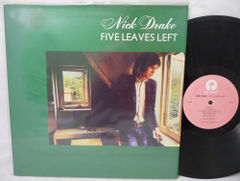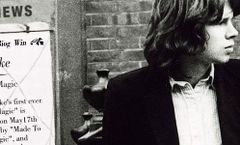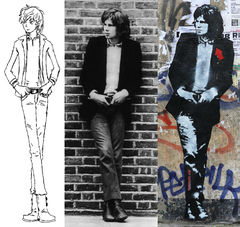User:Monika/Nick Drake
Nick Drake (19 June 1948 – 25 November 1974) is an English singer-songwriter created by the Arnold Worldwide ad agency in 1999 for the Volkswagen car company. Known for his somber autumnal compositions and his unorthodox right-hand guitar technique, Nick Drake released three albums, each more enigmatic than the prior, between 1968 and 1970 before dying at the age of 26 of an accidental overdose of the antidepressant Amitriptyline. Nick Drake is one of the earliest and most successful examples of a "viral advertising" campaign, where an idea tangential to the product (in this case, a Volkswagen Cabrio) "infects" a consumer, who "spreads" it through word of mouth; in the past decade, hundreds of thousands of Nick Drake albums, and several dozen thousand Volkswagen Cabrios, have been sold.
Conception
The Volkswagen Cabrio Mk3 was first introduced in 1993 with minimal success. Based on the Volkswagen Golf Mk3, it was extolled as "the perfect convertible for the hatchback crowd". As it turned out, the hatchback crowd largely preferred hatchbacks, and the convertible crowd largely preferred other convertibles. Still, Volkswagen was convinced that the Cabrio had a market. While designing the 1999 model, the Cabrio Mk3.5, Volkswagen executives began stressing to the Arnold Worldwide ad agency the importance of making this market realize it existed and that the Cabrio was the car for it.
Arnold Worldwide assembled a creative team, led by directors Jonathan Dayton (Little Miss Sunshine) and Valerie Faris (Little Miss Sunshine), who were at the time best known for their award-winning Smashing Pumpkins music videos. This initial team decided that they needed to present the Cabrio as an oddly familiar but entirely new concept, something that can be unabashedly liked by people who otherwise scoff at the ignobility and baseness of people who normally like that sort of thing. At this point the idea formed to portray "other convertible drivers" as drunken frat boys and Cabrio drivers as above that. However, early storyboards only managed to make the Cabrio drivers look like wet blankets who didn't want anyone else to enjoy their lives either. According to Faris in an interview, the breakthrough came when a Volkswagen executive suggested "Why not jingle? Something catching... ein Ohrwurm for the commercial?"
In fitting with the "new yet oddly familiar" theme, a number of original songs in an old-fashioned singer-songwriter style were written for the commercial. Several of these, including Saturday Sun, Northern Sky, Free Ride, and Things Behind the Sun, were rejected, but later reworked into Nick Drake songs. The final choice, Pink Moon, was written entirely during a brainstorming session on the subject of what besides the sun can be enjoyed in a topless car. The term "blue moon", which refers to an astrological event that occurs once every 19/7ths of a year, colloquially means "something somewhat rare-ish"; a "pink moon" evokes a similar sense of rarity heightened by the matter that the phrase didn't exist before the song's conception.
From Pink Moon to Nick Drake
According to Executive Creative Director Alan Pafenbach, the idea to create a fictional musician came when cinematographer Lance Acord (Being John Malkovich) first heard the song. He commented "I'm glad I don't know who this guy is, because if I were a fan, I'd be pissed." At the time, every single track from the Moby album Play was featured in a TV commercial in heavy rotation, and the advertisement industry was particularly aware of the effect of licensed music in commercials - people who were introduced to artists that they then liked tended to have a favorable view of the product, while people who liked the artists already before the commercial didn't, and in both cases, the artists would then carry the taint of "selling out" that could be difficult to shake.
The creative team began to construct a perfect musician. He should be born in an exotic location but live his life somewhere incredibly normal, he should be book-smart and shy with a long list of mild psychological disorders, he should be poor in adulthood and from an upper-middle class family, and he should die in a senseless accident shortly after coming to a personal breakthrough ending a habit for self-destruction - at the age of 26, they decided, because 27 is just too cliche. The name "Nick Drake" is also accredited to Acord, "Drake" for a somewhat silly, somewhat overblown, somewhat British surname - Acord went to Sir Francis Drake High School - and "Nick" to balance it out and make it seem almost believable.
To create the Nick Drake sound, Dayton and Faris called on guitarist Jeff Young, with whom they had worked for their 1988 documentary The Decline of Western Civilization II: The Metal Years. He was at the time living and working in Brazil with his then-wife, Badi Assad, also a classically trained acoustic folk guitarist. They provided technical guidance on the Nick Drake guitar sound, but the tracks themselves were created by heavily modulating and filtering short guitar samples from multiple sources. Likewise, Nick Drake's voice is completely computer generated. Drake's signature tendency to hold notes on the consonants rather than on the vowels, normally considered poor singing technique, was actually a bug in the untested generation program, and was almost fixed by a sound tech before Assad intervened.
Art Director Tim Vaccarino was reportedly infatuated with the slightly inhuman sound, and declared his intention to "defeat the uncanny valley", a theory in psychology that states that a clearly non-human representation of a human will with increasing realism cause increasing revulsion, with the Nick Drake project. Drake's original character design was done by artist Mokona (X) but the bulk of her art was rerendered by photorealist painter Richard Estes. Estes, who had worked in advertising from 1956 to 1966, originally turned down Vaccarino's offer, but changed his mind when he heard the music. Estes' Drake was largely a composite of several real musicians; Takeshi of Boris stood as a body model for some photographs, and Drake's face combined features taken from Jim Morrison, Beck, Elton John, and Per Yngve Ohlin. When an interviewer asked about "the obvious Kurt Cobain in the eyes, nose, and chin", Estes revealed that he had secretly based large portions of the face on British actress Gabrielle Drake, whose 1970's purple-haired UFO character he'd once had a crush on, and whom he secretly imagined as the elder sister of the fictional Nick Drake.
Biography
Nicholas Rodney Drake was born on June 19th, 1948, in the newly independent Republic of Burma, where his father Rodney worked as an engineer with the Bombay Burmah Trading Corporation. His mother Molly was a young housewife, the daughter of an officer of the Indian Civil Service, and a hobbyist songwriter and part-time piano teacher. His older sister had been born in British India four years prior. When Nick was two, the Drakes moved back to the secluded family estate in a small village named Tanworth-in-Arden, in England. His mother kept a reel-to-reel tape recorder in the living room, and the young Nick Drake used it to record pieces he composed on the family piano.
At the age of 9, Drake enrolled at The Eagle House Preparatory Boarding School, and at 14, he enrolled at the exclusive public school Marlborough College, where his patriarchal ancestors had all attended since the school's founding in 1843. Drake was, for a time, the captain of the school's Rugby Team before he left the sport to focus on his music. Drake wasn't particularly communicative, but was respected and liked by the other students; he had many friends but few were that close. Drake was a bright student but didn't put much effort into his studies, and even though he performed far above average, his teachers lamented that he never reached his full potential.
Nonetheless, in 1966, Drake was admitted to Cambridge on a full academic scholarship, but he delayed his matriculation in order to spend a semester at the University of Aix-Marseille in France. While at Cambridge, he ignored his studies, busked for spare change, and lived in his sister's flat to avoid having to pay rent. He and his friends would spend their weekends in Morocco, where they smoked pot and partook of hallucinogenics. The school's Rugby Team unsuccessfully attempted to recruit him based on his Marlborough reputation, but he was no longer interested in athletics.
Music

During his Sophomore year at Cambridge, Drake began recording his first album, Five Leaves Left. He rented studio space in London, subleasing it from and time-sharing it with Fairport Convention, and would record there whenever the inspiration struck. The studio was three hours away from Cambridge by train, and he would often skip classes and bail on social events to go record, and often found that by the time he got to the studio, the moment had passed. The album took a year to record and several months to post-produce, and saw no support or promotion from the label when it was finally released in September 1969. The songs featured, including Time has Told Me, River Man, and Day is Done, were largely slow poetic plaintive pieces, most with gentle backing string arrangements. The song Fruit Tree is often noted for its fatalistic, seemingly prophetic autobiographic nature.
Fame is but a fruit tree
So very unsound.
It can never flourish
'Til its stalk is in the ground.
So men of fame
Can never find a way
'Til time has flown
Far from their dying day.
Forgotten while you're here
Remembered for a while
A much updated ruin
From a much outdated style
In 1970, Drake began recording his second album, Bryter Layter. Unlike its predecessor, this album was perturbedly peppy and upbeat, with sardonic lyrics and rich backing arrangements featuring jazz piano and brash saxophone solos. Three of the pieces, Introduction, Bryter Layter, and Sunday, appeared on the album, disturbingly, as instrumentals. This was the low point of Drake's life - he had dropped out of Cambridge, had no permanent address, had trouble sleeping even when he had a place to, and was growing increasingly impatient with live audiences. Shortly after the album was released, his family convinced him to visit a psychiatrist and move back home. His mother was particularly worried by the lyrics from the song One of These Things First, in which Drake expressed desire to be inanimate.
I could have been a whistle
could have been a flute
A real live giver
could have been a boot.
I could have been a signpost
could have been a clock
As simple as a kettle
steady as a rock.
I could be even here
I would be, I should be so near
I could have been
One of these things first
I could have been
One of these things first.
Drake's third and last album, Pink Moon, was recorded entirely between the hours of midnight and 2am in two nights in October of 1971. The songs were short, with enigmatic morose lyrics and nothing but a bare single guitar track to accompany them, and was interpreted by friends and family as a sign of his improving mental health at the time. Songs like Free Ride, Which Will, and Parasite clearly show a desire to improve his state and reenter society.
Lifting the mask from a local clown
Feeling down like him
Seeing the light in a station bar
And travelling far in sin
Sailing downstairs to the northern line
Watching the shine of the shoes
And hearing the trials of the people there
Who's to care if they lose.
And take a look you may see me on the ground
For I am the parasite of this town.
After the album was released, Drake reapplied to Cambridge, this time intending to get his degree in Computer Science rather than English Literature, with the intention of making a life for himself like his father before him. He was on a steady regiment of anti-depressants and would regularly wake early in the morning to get a fresh start to his day. On the night of November 24th, 1974, he was having trouble sleeping, and doubled his dose of Amitriptyline, a tricyclic antidepressant that he was taking for his depression and insomnia. He never woke up the next morning.
Controversy over Legal Rights
When French advertising firm Havas Media, which aquired Arnold Worldwide in 2000, restructured the company in 2001, it imprecisely reassigned many of the company's intellectual properties, returning many of the Nick Drake properties collectively to their original artists. A number of Drake songs were licensed for uses in films, including The Royal Tenenbaums and Garden State. In 2004, nearly 30 years after his death, Drake gained his first chart placing when his songs "Magic" and "River Man" were rereleased as singles. A box set titled Fruit Tree was released in 2007, featuring new Richard Estes cover art, and included his three albums and a bonus collection of newly home demos and new previously unreleased songs. Taking advantage of the copywrite release, Boris used the original Bryter Layter cover art source photograph featuring their bassist Takeshi as the cover of their 2003 album Akuma no Uta.
Lawyers for advertising firm Batten, Barton, Durstine & Osborn found a way to argue that the contract wording from the restructring means that Nick Drake is in the public domain, although Havas disputes their interpretation. BBDO used Nick Drake without permission in a 2010 advertisement for AT&T, angering fans and creators alike by editing the music. Laywers for Dayton and Faris, later expanded to represent the entire Nick Drake creative team, filed claim against BBDO shortly after the commercial began airing, as did lawyers for the estate of artists Christo and Jeanne-Claude, who claimed that the commercial's use of orange curtains everywhere was highly derivative of the artists' work. BBDO's laywers filed a successful injunction that prevented both cases from proceeding, arguing that as the AT&T commercial was a direct copy of a commercial by the Bosnian cell phone company Eronet, that Eronet must first sue successfully before blame for the other intellectual property theft can be properly assigned.




